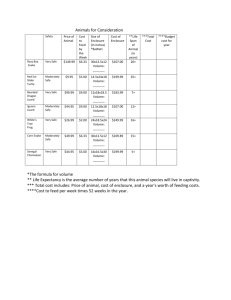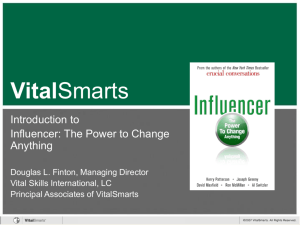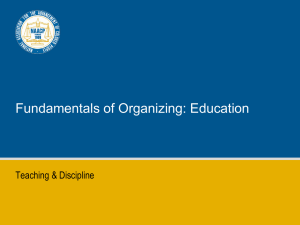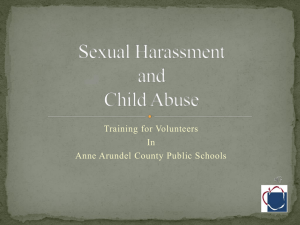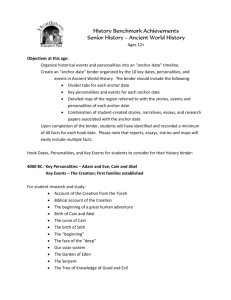Influence without Authority - IIBA Columbus Ohio Chapter
advertisement
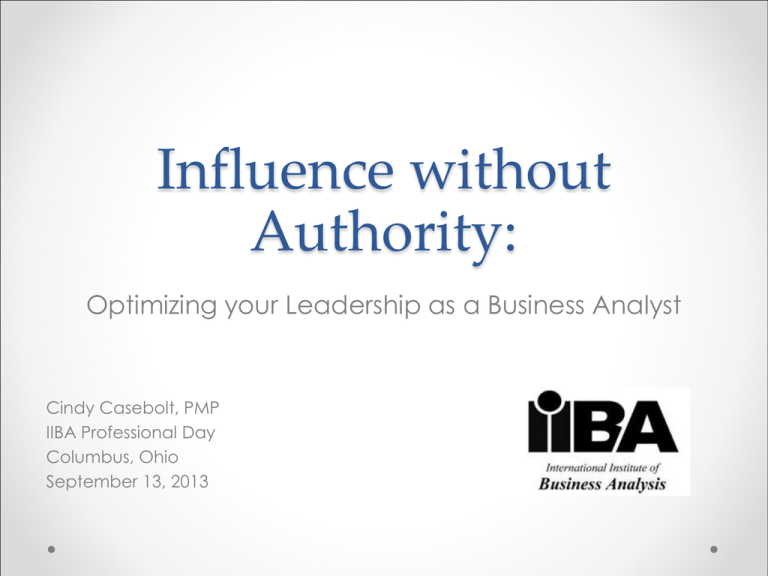
Influence without Authority: Optimizing your Leadership as a Business Analyst Cindy Casebolt, PMP IIBA Professional Day Columbus, Ohio September 13, 2013 Agenda • • • • • What is influence? Why is it important for business analysts? What are techniques to increase your influence? Further Reading Q&A Influence Defined - Influence is the ability of one person to affect the behavior of another. Why is it important for business analysts to influence their project teams and stakeholders? Influence as a Leader MANAGING REQUIREMENTS - Goes in the direction of the present vision - Solves problems and brings order LEADING REQUIREMENTS - Has a vision, inspires followers in pursuit of that vision - Uses power for influence and brings people along - Finds problems to solve - Uses available rewards and - Seeks opposing views to human motivations identify options - Manages conflicting views - Brings chaos to an by finding compromises organization in pursuit of a vision •Doing the Right Thing •Doing Things Right Techniques for Influence • • • • Understanding personalities Mapping social networks Choosing influence tactics and desired outcomes Identifying and modifying “vital behaviors” Understanding Personalities Understanding Personalities • To influence “D” type people… o Connect with the bottom line and show how the team will “win” • To influence “I” type people… o Show them recognition and approval of their work • To influence “S” type people… o Show them how they can support others and the team • To influence “C” type people…. o Give them clarification and complete understanding, consistency Understanding Personalities • To increase your influence as a “D”… o Stop, relax and take time to connect with your team • To increase your influence as an “I”… o Use a time management system – keep work along with fun • To increase your influence as an “S”… o Take a few risks – do something unpredictable • To increase your influence as a “C”… o Learn to trust and put the emphasis on people Mapping Social Networks “Trafficking in Trust: The Art and Science of Human Knowledge Networks” Karen Stephenson, Ph.D., “Social Anthropologist” http://www.drkaren.us/pdfs/chapter15.pdf Exercise: Social Network http://connectedness.blogspot.com/2005/04/pulse-taker-by-karen-stephenson.html Influence Outcomes • Commitment • Compliance • Resistance While in the real world, compliance may be the appropriate outcome from time to time, your effectiveness depends on your ability to get commitment from the key departments across the organization. Source: Richard Lepsinger, OnPoint Consulting Proactive Influence Tactics Level of Effectiveness Tactic Definition Most Effective Rational Persuasion Using logical arguments and factual evidence to show that a request or proposal is feasible and relevant for important task objectives. Most Effective Inspirational Appeals Appealing to a person’s values and ideals, or seeking to arouse the person’s emotions, to gain commitment for a request or proposal. Most Effective Consultation Asking the person to suggest improvements or help plan a proposed activity or change for which the person’s support is desired. Most Effective Collaboration Offering to provide relevant resources or assistance if the person will carry out a request or approve a proposed change. Moderately Effective Apprising Explaining how carrying out a request or supporting a proposal will benefit the person personally or will help to advance the person’s career. Moderately Effective Ingratiation Using praise and flattery before or during an attempt to influence someone to carry out a request or support a proposal. Moderately Effective Personal Appeals Asking the person to carry out the request or support a proposal out of friendship, or asking for a personal favor before saying what it is. Moderately Effective Exchange Offering something a person wants, or offering to recriprocate at a later time, if the person will do what you request. Least Effective Legitimating Tactics Establishing the legitimacy of a request or verifying that you have the authority to make it. Least Effective Coalition Tactics Enlisting the aid of others, or using the support of others, as a way to influence someone to do something. Least Effective Pressure Using demands, threats, frequent checking, or persistent reminders to influence someone to do something. Source: Richard Lepsinger, OnPoint Consulting Influencer: The Power to Change Anything • Identify 2-3 “Vital Behaviors” • Six Sources of Influence o o o o o o Values Skills Support Teamwork Incentives Environment Ron McMillan: For Powerful Change, Change Behavior http://www.youtube.com/watch?v=8ZWfXbGznGw&list=PL114AB9079C66B3C9 Exercise: Vital Behaviors With a partner, reflect on the video and try to determine 1-2 “vital behaviors” on your project team which, if modified, would do one or more of the following: o Increase quality of requirements gathered o Increase traceability of requirements o Increase effectiveness of scope management Further Reading Questions?


